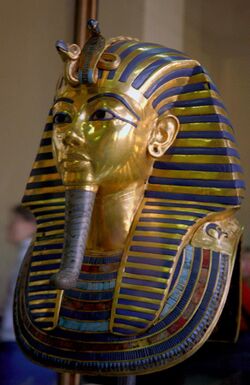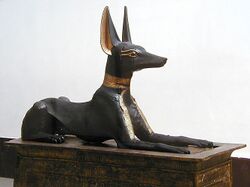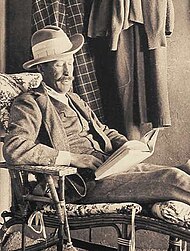Curse of the pharaohs
Topic: Unsolved
 From HandWiki - Reading time: 10 min
From HandWiki - Reading time: 10 min
The curse of the pharaohs or the mummy's curse is a curse alleged to be cast upon anyone who disturbs the mummy of an ancient Egyptian, especially a pharaoh. This curse, which does not differentiate between thieves and archaeologists, is claimed to cause bad luck, illness, or death. Since the mid-20th century, many authors and documentaries have argued that the curse is 'real' in the sense of having scientifically explicable causes such as bacteria or radiation. However, the modern origins of Egyptian mummy curse tales, their development primarily in European cultures, the shift from magic to science to explain curses, and their changing uses—from condemning disturbance of the dead to entertaining horror film audiences—suggest that Egyptian curses are primarily a cultural, not scientific, phenomenon.[1]
There are occasional instances of genuine ancient curses appearing inside or on the façade of a tomb, as in the case of the mastaba of Khentika Ikhekhi of the 6th Dynasty at Saqqara. These appear to be directed towards the ka priests to protect the tomb carefully and preserve its ritual purity rather than as a warning for potential robbers. There had been stories of curses going back to the 19th century, but they multiplied after Howard Carter's discovery of the tomb of Tutankhamun. Despite popular misconceptions, no curse was found inscribed in the Pharaoh's tomb.[2] The evidence for curses relating to Tutankhamun is considered to be so meager that Donald B. Redford called it "unadulterated claptrap".[3]
Tomb curses
Curses relating to tombs are extremely rare, possibly because the idea of such desecration was unthinkable and even dangerous to record.[2] They most frequently occur in private tombs of the Old Kingdom era.[4] The tomb of Ankhtifi (9–10th dynasty) contains the warning: "any ruler who... shall do evil or wickedness to this coffin... may Hemen ([a local deity]) not accept any goods he offers, and may his heir not inherit". The tomb of Khentika Ikhekhi (6th dynasty)[5] contains an inscription: "As for all men who shall enter this my tomb... impure... there will be judgment... an end shall be made for him... I shall seize his neck like a bird... I shall cast the fear of myself into him".[2]
Curses after the Old Kingdom era are less common though more severe, sometimes invoking the ire of Thoth or the destruction of Sekhemet.[4] Zahi Hawass quotes an example of a curse: "Cursed be those who disturb the rest of a Pharaoh. They that shall break the seal of this tomb shall meet death by a disease that no doctor can diagnose."[6]
Modern accounts
Hieroglyphs were not deciphered until the early 19th century, so reports of curses before this are simply perceived bad luck associated with the handling of mummies and other artifacts from tombs. In 1699, Louis Penicher wrote an account in which he recorded how a Polish traveler bought two mummies in Alexandria and embarked on a sea journey with the mummies in the cargo hold. The traveler was alarmed by recurring visions of two specters, and the stormy seas did not abate until the mummies were thrown overboard.[2]
Zahi Hawass recalled that, as a young archaeologist excavating at Kom Abu Billo, he had to transport several artifacts from the Greco-Roman site. He states that his cousin died on that day, that his uncle died on its first anniversary, and that on the third anniversary, his aunt died. Years later, when he excavated the tombs of the builders of the pyramids at Giza, he encountered the curse: "All people who enter this tomb who will make evil against this tomb and destroy it may the crocodile be against them in water, and snakes against them on land. May the hippopotamus be against them in water, the scorpion on land."[6] Though claiming not to be superstitious, Hawass decided not to disturb the mummies. However, he also claims he was later involved in the removal of two child mummies from Bahariya Oasis to a museum and reported that he was haunted by the children in his dreams – a phenomenon which he claims did not stop until the mummy of the father was reunited with the children in the museum.[6][7]
The idea of a mummy reviving from the dead, an essential element of many mummy curse tales, was developed in The Mummy!: Or a Tale of the Twenty-Second Century, an early work combining science fiction and horror, written by Jane C. Loudon and published anonymously in 1827. Louisa May Alcott was thought by Dominic Montserrat to have been the first to use a fully formed "mummy curse" plot in her 1869 story Lost in a Pyramid, or The Mummy's Curse, a hitherto forgotten piece of mummy fiction that he rediscovered in the late 1990s.[8] However, two stories subsequently discovered by S. J. Wolfe, Robert Singerman and Jasmine Day – The Mummy’s Soul (Anonymous, 1862) and After Three Thousand Years (Jane G. Austin, 1868) – have similar plots, in which a female mummy takes magical revenge upon her male desecrator. Jasmine Day, therefore, argues that the modern European concept of curses is based upon an analogy between desecration of tombs and rape, interpreting early curse fiction as proto-feminist narratives authored by women. The Anonymous and Austin stories predate Alcott's piece, raising the possibility that even earlier "lost" mummy curse prototype fiction awaits rediscovery.[9]
Opening of Tutankhamun's tomb
The belief in a curse was brought to many people's attention due to the deaths of a few members of Howard Carter's team and other prominent visitors to the tomb shortly thereafter. Carter's team opened the tomb of Tutankhamun (KV62) in 1922, launching the modern era of Egyptology.
The famous Egyptologist James Henry Breasted worked with Carter soon after the first opening of the tomb. He reported how Carter sent a messenger on an errand to his house. On approaching his home the messenger thought he heard a "faint, almost human cry". Upon reaching the entrance he saw the birdcage occupied by a cobra, the symbol of the Egyptian monarchy. Carter's canary had died in its mouth and this fueled local rumors of a curse.[10] Arthur Weigall, a previous Inspector-General of Antiquities to the Egyptian Government, reported that this was interpreted as Carter's house being broken into by the Royal Cobra, the same as that worn on the King's head to strike enemies (see Uraeus), on the very day the King's tomb was being broken into.[11] An account of the incident was reported by The New York Times on 22 December 1922.[12]
The first of the deaths was that of Lord Carnarvon, who financed the excavation. He had been bitten by a mosquito, and later slashed the bite accidentally while shaving. It became infected and that resulted in blood poisoning. Two weeks before Carnarvon died, Marie Corelli wrote an imaginative letter that was published in the New York World magazine, in which she quoted an obscure book that confidently asserted that "dire punishment" would follow any intrusion into a sealed tomb. A media frenzy followed, with reports that a curse had been found in the King's tomb, though this was untrue.[4] The superstitious Benito Mussolini, who had once accepted an Egyptian mummy as a gift, ordered its immediate removal from the Palazzo Chigi.[13]
Sir Arthur Conan Doyle, creator of Sherlock Holmes and spiritualist, suggested that Lord Carnarvon's death had been caused by "elementals" created by Tutankhamun's priests to guard the royal tomb, and this further fueled the media interest.[14] Arthur Weigall reported that six weeks before Carnarvon's death, he had watched the Earl laughing and joking as he entered the King's tomb and said to a nearby reporter (H. V. Morton), "I give him six weeks to live."[15] The first autopsy carried out on the body of Tutankhamun by Dr. Derry found a healed lesion on the left cheek, but as Carnarvon had been buried six months previously it was not possible to determine if the location of the wound on the King corresponded with the fatal mosquito bite on Carnarvon.[16]
A study of documents and scholarly sources led The Lancet to conclude it unlikely that Carnarvon's death had anything to do with Tutankhamun's tomb, refuting another theory that exposure to toxic fungi (mycotoxins) had contributed to his demise. The report points out that the Earl was only one of many to enter the tomb, on several occasions and that none of the others were affected. The cause of Carnarvon's death was reported as "'pneumonia supervening on [facial] erysipelas,' (a streptococcal infection of the skin and underlying soft tissue). Pneumonia was thought to be only one of various complications, arising from the progressively invasive infection, that eventually resulted in multiorgan failure." The Earl had been "prone to frequent and severe lung infections" according to The Lancet and there had been a "general belief ... that one acute attack of bronchitis could have killed him. In such a debilitated state, the Earl's immune system was easily overwhelmed by erysipelas."[17]
In 1925, the anthropologist Henry Field, accompanied by Breasted, visited the tomb and recalled the kindness and friendliness of Carter. He also reported how a paperweight given to Carter's friend Sir Bruce Ingram was composed of a mummified hand with its wrist adorned with a scarab bracelet marked with, "Cursed be he who moves my body. To him shall come fire, water, and pestilence." Soon after receiving the gift, Ingram's house burned down, followed by a flood when it was rebuilt.[18]
Howard Carter was entirely skeptical of such curses,[19] dismissing them as 'tommy-rot' and commenting that "the sentiment of the Egyptologist ... is not one of fear, but of respect and awe ... entirely opposed to foolish superstitions".[20] In May 1926 he reported in his diary a sighting of a jackal of the same type as Anubis, the guardian of the dead, for the first time in over thirty-five years of working in the desert, although he did not attribute this to supernatural causes.[21][22]
Skeptics have pointed out that many others who visited the tomb or helped to discover it lived long and healthy lives. A study showed that of the 58 people who were present when the tomb and sarcophagus were opened, only eight died within a dozen years. All the others were still alive, including Howard Carter, who died of lymphoma in 1939 at the age of 64.[23][24] The last survivors included Lady Evelyn Herbert, Lord Carnarvon's daughter, who was among the first people to enter the tomb after its discovery in November 1922, who lived for a further 57 years and died in 1980,[25] and American archaeologist J.O. Kinnaman, who died in 1961, 39 years after the event.[26]
Scientific speculations
It has been suggested that the toxic spores of the fungus Aspergillus flavus, besides possibly contributing to deaths following a 1973 tomb opening in Poland, may also have contributed to some of the allegedly Tutankhamun-related deaths, particularly the deaths of Lord Carnarvon, George Jay Gould, and Arthur Mace,[27][28] though the link has been disputed (at least in Carnarvon's case).[28]
Deaths popularly attributed to Tutankhamun's curse
The tomb was opened on 29 November 1922.
- George Herbert, 5th Earl of Carnarvon, financial backer of the excavation, who was present at the tomb's opening, died on 5 April 1923 after a mosquito bite became infected; he died 4 months and 7 days after the opening of the tomb.[29][30]
- George Jay Gould I, a visitor to the tomb, died in the French Riviera on 16 May 1923 after he developed a fever following his visit.[31]
- A. C. Mace, a member of Carter's excavation team, died in April 1928, having suffered from pleurisy and pneumonia in his final years.[32]
- Captain The Hon. Richard Bethell, Carter's secretary, died on 15 November 1929: died in bed in a Mayfair club, the victim of a suspected smothering.[33]
- Howard Carter opened the tomb on 16 February 1923 and died well over sixteen years later on 2 March 1939; however, some have still attributed his death to the curse.[34]
See also
The Universal horror films The Mummy (1932), The Mummy's Hand (1940), and the latter's sequels, contain references to a curse foretelling death to those who enter the tombs.
- Pharaoh's Curse (1957 film)
- The Curse of the Mummy's Tomb (1964 film)
- The Curse of King Tut's Tomb (1980 film)
References
- ↑ Day 2006.
- ↑ 2.0 2.1 2.2 2.3 J. Paterson-Andrews, C. Andrews, p. 190.
- ↑ The Boy Behind the Mask, Charlotte Booth (quoting Donald B. Redford), p. xvi, Oneword, 2007, ISBN:978-1851685448
- ↑ 4.0 4.1 4.2 Ancient Egypt, David P. Silverman, p. 146, Oxford University Press US, 2003, ISBN:019521952X
- ↑ James, Thomas Garnet Henry (1953). "The Mastaba of Khentika Called Ikhekhi". Archaeological Survey of Egypt 30. https://archive.org/details/ASE-EEF30. Retrieved 12 January 2022.
- ↑ 6.0 6.1 6.2 Valley of the Golden Mummies, Zahi A. Hawass, pp. 94–97, American University Press in Cairo Press, 2000, ISBN:9774245857
- ↑ "Al-Ahram Weekly | Heritage | Dig days: A born archeologist". 2012-02-06. http://weekly.ahram.org.eg/2004/675/he3.htm.
- ↑ Consuming Ancient Egypt, Sally MacDonald, Michael Rice, p. 26, University College, London. Institute of Archaeology, Routledge Cavendish, 2003, ISBN:1844720039
- ↑ Day 2006, pp. 46–47, 52–53.
- ↑ Winstone 2006, p. 178.
- ↑ The Face of Tutankhamun, Christopher Frayling, p. 232, Faber & Faber, 1992, ISBN:0571168450
- ↑ "Times Man Views Splendors of the Tomb of Tutankhamen", The New York Times, 22 December 1922, Retrieved 12 May 2009 [1]
- ↑ Gunther, John (1940). Inside Europe. Harper & Brothers. pp. 247–248. https://archive.org/stream/in.ernet.dli.2015.149663/2015.149663.Inside-Europe#page/n269/mode/2up.
- ↑ J. Paterson-Andrews, C. Andrews, p. 196
- ↑ Winstone 2006, p. 291.
- ↑ In the Valley of the Kings – Howard Carter and the Mystery of King Tutankhamun's Tomb, Daniel Meyerson, p. 158, Ballantine Books, 2009, ISBN:978-0345476937
- ↑ Cox, Ann M (7 June 2003). "The death of Lord Carnarvon". Lancet (The Lancet) 361 (9373): 1994. doi:10.1016/S0140-6736(03)13576-3. PMID 12801779. https://www.thelancet.com/journals/lancet/article/PIIS0140-6736(03)13576-3/fulltext. Retrieved 9 June 2021.
- ↑ Winstone 2006, p. 294.
- ↑ J. Paterson-Andrews, C. Andrews, p. 198.
- ↑ Winstone 2006, p. 326.
- ↑ Winstone 2006, pp. 295–296.
- ↑ Carter, Howard. Excavation journal, May 1926.. The Griffith Institute, Oxford. http://www.griffith.ox.ac.uk/discoveringTut/journals-and-diaries/season-4/journal.html.
- ↑ David Vernon in Skeptical – a Handbook of Pseudoscience and the Paranormal, ed. Donald Laycock, David Vernon, Colin Groves, Simon Brown, Imagecraft, Canberra, 1989, ISBN:0731657942, p. 25.
- ↑ "Egypt: The Mummy Curse of Tutankhamun" (in ru). http://www.touregypt.net/featurestories/curse.htm.
- ↑ Bill Price (2007). Tutankhamun, Egypt's Most Famous Pharaoh. Hertfordshire]: Pocket Essentials. p. 138. ISBN 978-1842432402. https://archive.org/details/tutankhamunegypt0000pric/page/138.
- ↑ "Death Claims Noted Biblical Archaeologist", Lodi News-Sentinel, 8 September 1961, Retrieved 9 May 2014
- ↑ Al-Shamahi, Ella (2022). "Tutankhamun: Secrets of the Tomb". Channel 4. https://decider.com/2018/03/13/troy-the-odyssey-is-like-if-tommy-wiseau-rewrote-homer/.
- ↑ 28.0 28.1 Cox, Ann M. (7 June 2003). "The death of Lord Carnarvon". The Lancet (Elsevier Ltd.) 361 (9373): 1994. doi:10.1016/S0140-6736(03)13576-3. PMID 12801779. https://www.thelancet.com/journals/lancet/article/PIIS0140-6736(03)13576-3/fulltext?code=lancet-site. Retrieved 18 September 2021.
- ↑ "Why we love mummies". Pittsburgh Tribune-Review. http://www.pittsburghlive.com/x/pittsburghtrib/living/movies/s_580209.html. "Upon breaching the tomb, something stung Carnarvon on the cheek. He died several months later. Newspapers sensationalized his death as the fulfillment of an ancient mummy's curse. A rumor spread that there was an inscription over the tomb promising death to anyone who opened the tomb of the pharaoh. One recent theory is Carnarvon might have ingested anthrax spores deliberately placed in the tomb by ancient Egyptian priests to thwart tomb robbers."
- ↑ "Carnarvon Is Dead Of An Insect's Bite At Pharaoh's Tomb. Blood Poisoning and Ensuing Pneumonia Conquer Tut-ankh-Amen Discoverer in Egypt.". The New York Times. 5 April 1923. https://www.nytimes.com/1923/04/05/archives/carnarvon-is-dead-of-an-insects-bite-at-pharaohs-tomb-blood.html. "The Earl of Carnarvon died peacefully at 2 o'clock this morning. He was conscious almost to the end."
- ↑ "George J. Gould Dies in Villa in France.". The New York Times. 17 May 1923. https://www.nytimes.com/1923/05/17/archives/george-j-gould-dies-in-villa-in-france-leaves-30000000-with-his.html. "George Jay Gould died this morning at 3:30 at the Villa Zoralde, Cap Martin, where he had been living for some months with his wife and her two children. His death, it was stated at the villa, came quietly and was expected, as he had never rallied from the illness from which he had been suffering all Winter."
- ↑ Winstone 2006, p. 310.
- ↑ "Curse of Tutankhamun may have been work of Satanist killer". The Telegraph. https://www.telegraph.co.uk/news/worldnews/africaandindianocean/egypt/8878314/Curse-of-Tutankhamun-may-have-been-work-of-Satanist-killer.html. "Captain Richard Bethell (15 November 1929): Howard Carter's 46-year-old personal secretary was found dead in his bed at Mayfair's exclusive Bath Club. Bethell was said to have been in perfect health. It was initially thought that he died of a heart attack but his symptoms raised suspicion that he was smothered to death as he slept. Crowley had only recently returned to London and was often a guest of novelist W. Somerset Maugham at the club."
- ↑ "Howard Carter, 66, Egyptologist, Dies.". The New York Times. https://www.nytimes.com/learning/general/onthisday/bday/0509.html. "Howard Carter, Egyptologist who earned world fame for his discovery and exploration, in association with the fifth Earl of Carnarvon, of the tomb of Tut-ankh-Amen, died in his London home today at the age of 66."
Bibliography
- Day, Jasmine (2006). The Mummy's Curse: Mummymania in the English-speaking World. Routledge. ISBN 978-0415340229.
- Hamilton-Paterson, James (1978). Mummies: Death and Life in Ancient Egypt, Carol Andrews, p. 197, Collins for British Museum Publications, ISBN:0001955322
- Winstone, H.V.F. (2006). Howard Carter and the discovery of the tomb of Tutankhamun. Barzan, Manchester.. ISBN 1905521049. OCLC 828501310. https://www.worldcat.org/oclc/828501310.
External links
- Zack Rolly (16 February 2011). "Tutankhamun – the 'Boy King'". h2g2. http://www.h2g2.com/approved_entry/A517114.
- Dunning, Brian (June 24, 2008). "Skeptoid #106: King Tut's Curse!". https://skeptoid.com/episodes/4106.
 |
 KSF
KSF


